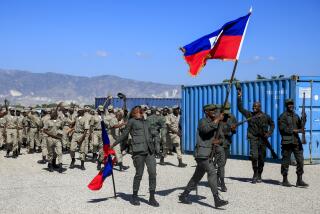Panama Lessons: Soldiers Need Police and Urban War Training
- Share via
WASHINGTON — In the first critical assessment of the Panama invasion since 22,500 U.S. soldiers stormed the streets of Panama City in December, Army officials said Tuesday they have concluded they must increase the training of troops in police functions and urban warfare.
Among other key lessons learned from the Panama invasion, senior Army officials said, is that they may need to increase the number of active-duty troops specializing in “civil affairs” functions such as public works and government administration.
Meanwhile, the Bush Administration said Tuesday that it has reduced U.S. troop strength in Panama to the pre-invasion level of about 13,000, a move intended in part to blunt concern by America’s allies that the United States would maintain an occupying force indefinitely.
The activities of those troops remaining in Panama reflect some of the findings contained in the post-invasion assessment, which was developed by a special unit of Army analysts and outlined on Feb. 4 to the Army’s top leadership, including Chief of Staff Gen. Carl E. Vuono.
For example, many U.S. soldiers now are engaged in helping the government of Panama’s President Guillermo Endara maintain order and rebuild institutions decimated by years of Gen. Manuel A. Noriega’s rule--as well as by the U.S. invasion.
In reviewing its performance in the Dec. 20 military operation that removed Noriega from office, the Army found much that had gone right, including the “discipline of fire,” or restraint in combat, displayed by its soldiers in order to reduce civilian casualties.
At the same time, the Army found itself wanting in several areas, and the assessment could lead to policy changes both large and small for the nation’s future land forces, Army officials said.
-The specialty helicopter “door gunner,” a combat role that was eliminated after the Vietnam War and had to be improvised by other soldiers during the Panama operation, could be restored.
-The increasing dependence on arcade-style simulations for combat training could be curtailed, because soldiers with live-fire training experience were more confident and performed better in Panama.
-The process of identifying dead and wounded and notifying their next-of-kin will be streamlined “so we can tell families before CNN (Cable News Network) does,” in the words of one senior officer.
Pentagon sources said the Army’s analysis of the operation dubbed “Just Cause” will help guide service officials in developing new training techniques and organizational initiatives designed to improve the Army’s performance in future military operations.
In the wake of the U.S. invasion of Grenada in 1983, a scathing self-review by the U.S. military set the stage for a number of improvements that officials said paid off in the Panama operation.
Among those earlier lessons was a recommendation that units expected to fight should be involved in the early planning of their goals and the operations they will conduct to achieve those goals.
As a result, the Army largely planned, ran and conducted the Panama operation, which was known originally as Black Knight. A small naval contingent and a Panama-based Marine detachment also participated.
“The practitioners planned this operation,” said one senior Army official. “Those who had to fight planned their fight and then fought their plan.”
Units involved in the Panama operation devised back-up plans, many of which were used. When communications equipment was misplaced in an errant airdrop, another communications network was quickly established. When a special-operations helicopter failed before it could transport an imprisoned American intelligence agent away from a Panamanian prison at Gamboa, the Ranger unit called on a back-up armored personnel carrier to do the job.
In addition, the Army’s role in advance planning allowed almost all of the units involved in the operation to rehearse their parts for two months.
Pentagon officials said that analysts working under the direction of the Joint Chiefs of Staff are still reviewing some of the larger lessons learned from Panama, including the way that the Pentagon’s war planners translated political goals into military missions.
The office of Pentagon press spokesman Pete Williams also is conducting a review of the Pentagon’s handling of news coverage of the Panama invasion.
Like the Army’s assessment, the Joint Chiefs of Staff review is certain to focus attention on the need for American forces to be better trained in dealing with the aftermath of a full-fledged military operation.
More to Read
Sign up for Essential California
The most important California stories and recommendations in your inbox every morning.
You may occasionally receive promotional content from the Los Angeles Times.














